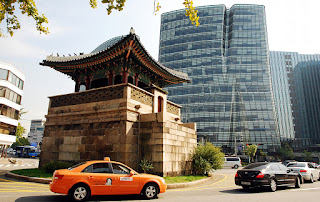 |
| I didn't have much time to see the city. The photos are from walking to the Royal Palaces or the Buddhist temple. This is City Hall |
 |
| It is now used for events as you will see later in this posting |
 |
| Reflection |
 |
| Behind this bright object is a canal that provides a relaxing walk in the midst of the city. Some photos of that later |
 |
| This is the statue of Admiral Yi Sunshin in Gwanghwamun Square. Yi Sun-shin was a Korean naval commander, famed for his victories against the Japanese navy during the Imjin war in the Joseon Dynasty |
 |
| It also recalls how he fought 23 battles without a single defeat |
 |
| Reflection |
 |
| The aliens have landed! Looks like it was a tough trip! |
 |
| The old tram car 381 in front of the Seoul Museum of History. This historical tram traveled in Seoul from 1930 to 1968 |
 |
| A very interesting wall. You can see me in the bottom right hand corner taking the photo |
 |
| Again, the old and the new. While I always love the traditional, I like the modern architecture in Korea. There are many interestingly designed buildings |
 |
| Very tall and imposing! |
 |
| A bike parked on a wall. Not sure I fancy the saddle! |
 |
| The old and the new ways, or the poor and the rich |
 |
| Seoul has many modern shopping centres but there are also more traditional places |
 |
| Always good to stop for a break. Seoul has a plethora of different coffee outlets. I don't think I've ever seen so many different individually owned ones apart from the usual brand names |
 |
| Bright and bold signage |
 |
| An indoor market area selling mostly food |
 |
| A string of fish |
 |
| This is obviously a popular item |
 |
| The canal I mentioned earlier. It is the ChonGae Canal. As you can see it is very clean and I saw a lot of fish including some pretty big ones. |
 |
| It's a great place to be on a sunny late afternoon as the sun begins to set. It was originally a naturally formed river that collected mountain streams and channeled water to the open sea. |
 |
| Night is falling an I'm back at City Hall where things are beginning to happen. I don't know what this large rope was for. Tug o' War? |
 |
| Suddenly I heard music and went over to find the source |
 |
| Traditionally and colourfully dressed musicians |
 |
| They walked/danced around Seoul Plaza |
 |
| I don't know the significance of these lovely paper flowers but they are a very colourful way to end this post. Next I'll post photos of another Royal Palace |










































